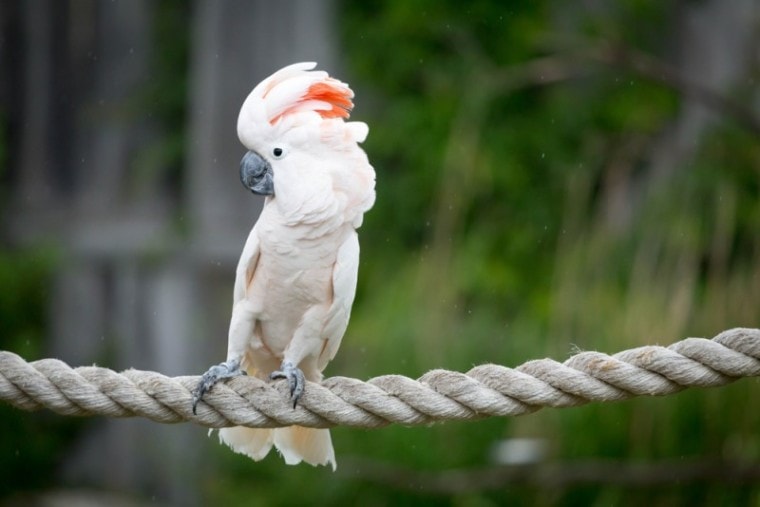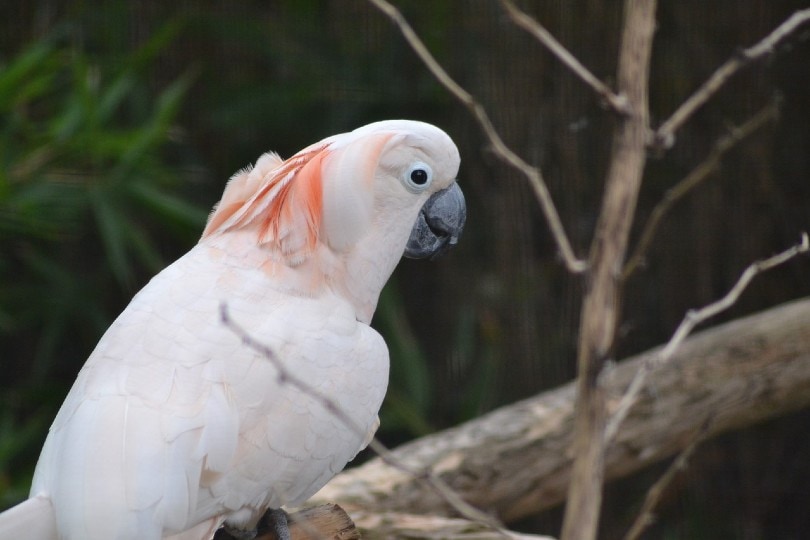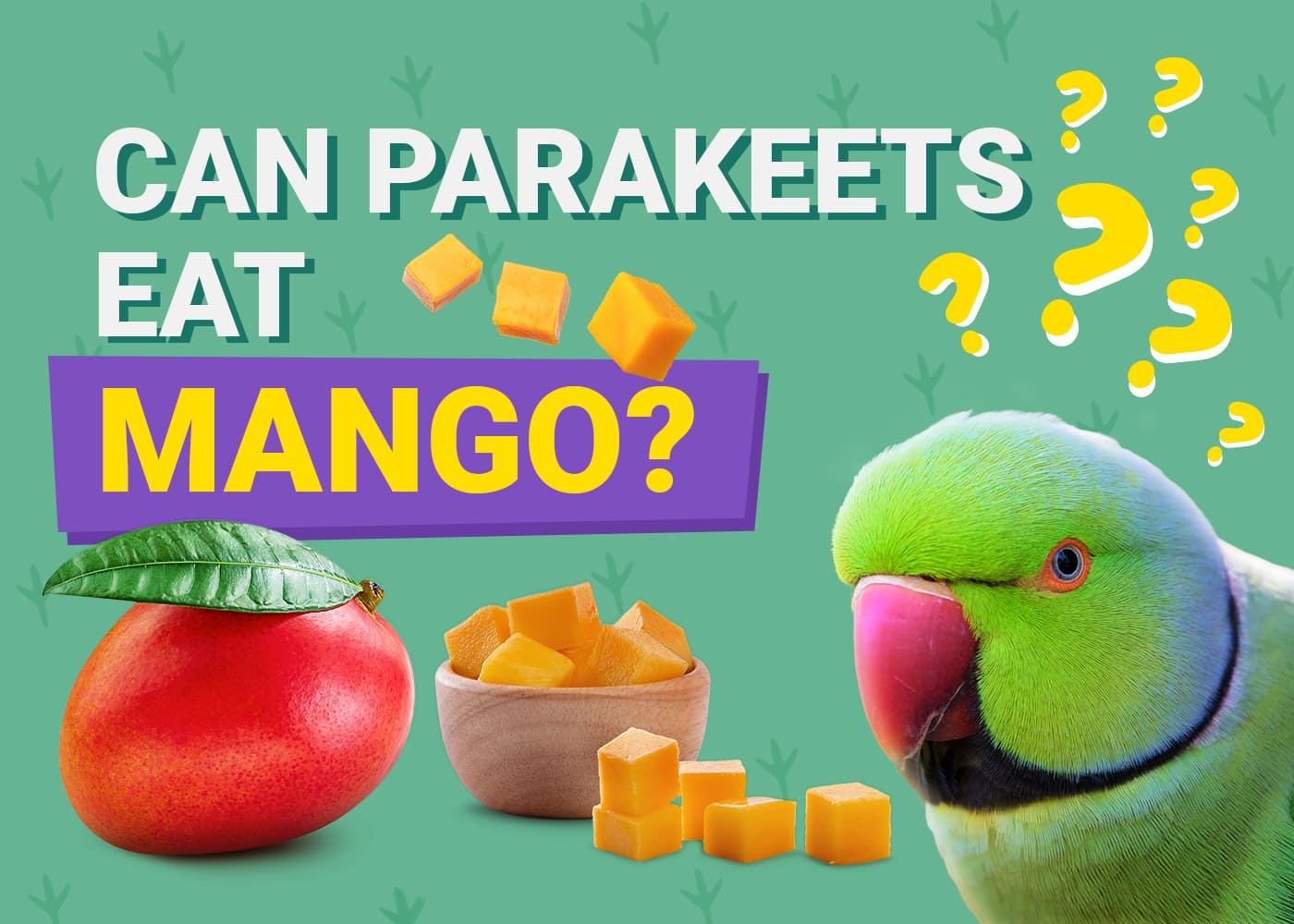
The Moluccan (salmon-crested) cockatoo bird is a small to medium-sized parrot native to the Indonesian island of New Guinea. They have a long lifespan, with some living up to 60 years old in captivity!
These birds are very affectionate and love being around people and other animals. The Moluccan cockatoo can make an excellent companion for someone who’s looking for a pet that will be both loyal and interactive with them throughout the day.
If you’re considering this type of pet, read on for more information about their personality, diet, and care needs!
Species Overview

| Common Names: | Salmon-Crested Cockatoo |
| Scientific Name: | Cacatua moluccensis |
| Adult Size: | 15–20 inches |
| Life Expectancy: | 45–65 years |
Origin and History
The Moluccan cockatoo is originally from the Indonesian island of New Guinea. These birds are native to rainforests and tropical lowlands, making them perfect for a home in warmer climates with plenty of sunshine!
Their appearance made them popular with locals and tourists alike until their acceptance as a pet grew worldwide. They are now found in abundance at pet stores all over America.
Temperament
Moluccan cockatoos are very intelligent, social birds who love to interact with people and other animals.
They enjoy playing games and puzzles for mental stimulation and need plenty of physical exercising daily. While these pets can be highly energetic at times, they can also have periods where they seem withdrawn or depressed, indicating an issue such as feather plucking or another behavioral condition that needs more attention.
They’re very social animals that can be affectionate towards both humans and animals alike as long as they aren’t neglected or harshly treated by their owners.
The Moluccan cockatoo is not recommended for homes with small children because these birds require gentle treatment from their human family members, especially if you want your bird to live up to 80 years old like some cockatoos on record!
If you plan on introducing this pet into your home, be prepared to have a lot of time (and patience) on your hands, but the reward is worth it!
Speech & Vocalizations
Cockatoos are known for singing and can also mimic various sounds. They have a wide range of vocalizations, which some compare to that of a parrot or mynah bird.
Cockatiels, in particular, enjoy high pitched noises like whistling and squeaky toys as it stimulates them mentally. On the other hand, Moluccan cockatoos produce lower-pitched cooing and screeching calls, typically during the early hours of the day.
You may need to invest in earplugs if your new pet is bothersome in the mornings!
Cockatoos can be taught to speak short phrases and words, though not as easily as parrots. They may be quieter in nature than other birds but are still talkative with those they know well.

Moluccan Cockatoo Colors and Markings
Moluccan cockatoos are easily recognizable by their bright salmon-pink crest feathers. They also have black and white facial stripes, which are much darker than that of a cockatiel. The rest of the body is mainly grey, with yellowish highlights on the wings and tail feathers in males.
Caring for the Moluccan Cockatoo
Moluccan cockatoos need intermediate care; this includes an hour-long session with fresh fruit and vegetables every day along with plenty of toys for entertainment! They love music, mirrors, laser beamers, swings, anything that will keep your little one entertained! Moluccans do best when kept at 60 degrees Fahrenheit without drafts but can handle warmer temperatures.
Caring for a bird is something you need to prepare for. In the case of the Moluccan cockatoo, they need a lot of attention and time from you. They will want to be out with their human companion as much as possible, and they are brilliant creatures, so we recommend keeping them busy mentally with puzzles or games when not spending quality time together.
You might also need to take your pet to the vet for a check-up at least once every year, but it’s worth the time and money.
Common Health Problems
Cockatoos are susceptible to many of the same health problems that other parrots are, but they can also have some unique issues.
The most common illness among cockatoos is psittacosis or, as it’s more commonly known as “parrot fever.” This condition can be fatal if not treated appropriately, so make sure to take your bird in for a check-up if you notice that it’s sneezing, having trouble breathing, or has a runny nose.
Other common issues among cockatoos are ringworm and bacterial infections of the respiratory system.
Cocktails might also suffer from obesity which can be cured by reducing their intake of high-fat foods such as nuts and dried fruit and adding some more low-calorie vegetables to their diet.

Diet and Nutrition
In the wild, cockatoos eat nuts and seeds, but this kind of diet isn’t practical in captivity.
Try to feed your cockatoo a combination of fresh vegetables, healthy grains such as rice or oats, natural unsalted popcorn for treats, and some fruit like apples, which will act as antioxidants to balance out their high-fat diets.
In addition, cockatoos need more calcium than other parrots because they are constantly growing and molting feathers. One of the best ways to help them get a healthy dose is by putting eggshells in their water or making your own supplement out of ground-up oyster shells.
Your pet will eventually get curious about your human food. Avoid letting them eat any salty foods, and keep an eye on the sugar intake as they could become hyperactive.
Finally, water is essential for your cockatoo. They need to drink a minimum of one cup (eight ounces) per day.
Exercise
Cockatoos are considered big birds, so they need to be let out of their cages every day. Exercise is important for keeping your bird happy and healthy because it strengthens the muscles and bones, which reduces the risk of obesity.
If you don’t have much time outside of work hours, a play stand for inside use would be an excellent idea. Cockatoos are intelligent birds that enjoy solving puzzles; such stands can provide both exercises as well as mental stimulation.
When you are home, you can play with your pet by stimulating his use of its beak and feet or by allowing him to stretch his wings.
Cockatoos also enjoy walking outdoors, and you can take them for a walk on a leash. If this is not possible in your area or if the weather is too hot, try to find someplace shady where there are trees to provide shelter from direct sunlight (such as an old oak tree).
If it’s cold out, make sure that your pet stays warm with additional layers of clothing.
They love wearing coats made especially for birds!
Training Your Cockatoo
You will need patience and consistency when training your cockatoo because they’re intelligent but stubborn creatures. To teach them tricks like stepping up onto their perch or giving kisses, reward them with treats after doing what you ask; whether they comply immediately will depend on their mood.
Where to Adopt or Buy a Moluccan Cockatoo
Moluccan cockatoos are one of the most common pet cockatoos in the United States, and it’s not hard to find one for adoption or purchase. There are many reputable breeders you can search on Google who offer adoptions but also be wary of backyard breeders that may have fewer regulations.
You may also find some in pet shops or on websites such as Craigslist or Facebook marketplace.
When buying a cockatoo, you’ll want to ensure that it’s healthy and has been handled by humans before, so they’re not scared of them. Be wary also if the bird is too young because their immune systems are still developing, which makes them susceptible to illness from exposure to other birds in pet stores.
Final Thoughts
If you’re looking for a unique pet that will brighten up any home, look no further than the Moluccan cockatoo.
These beautiful and imposing birds are recognizable by their pink crest and can be quite personable if they are often handled as chicks while young.
They make great pets because of how social they are with humans and other animals alike. If you want to learn more about these amazing bird species or others like them, read our blog!
- Related Read: 10 Australian Dog Breeds (with Pictures)
Featured Image Credit: Imran Ashraf, Shutterstock









